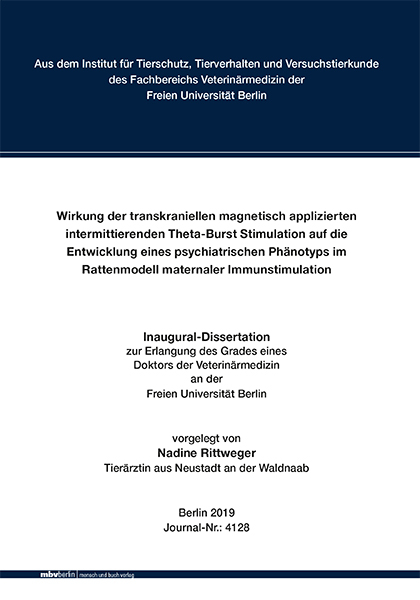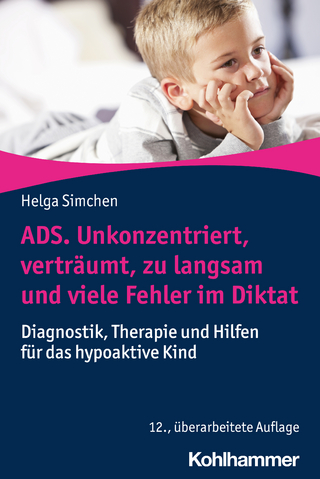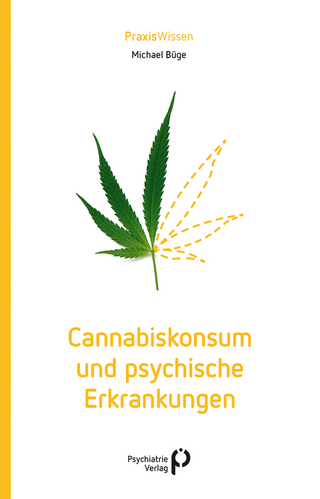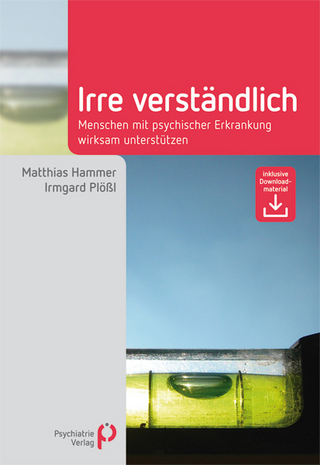
Wirkung der transkraniellen magnetisch applizierten intermittierenden Theta-Burst Stimulation auf die Entwicklung eines psychiatrischen Phänotyps im Rattenmodell maternaler Immunstimulation
Seiten
2019
|
1. Aufl.
Mensch & Buch (Verlag)
978-3-86387-994-5 (ISBN)
Mensch & Buch (Verlag)
978-3-86387-994-5 (ISBN)
- Keine Verlagsinformationen verfügbar
- Artikel merken
Schizophrenie ist weltweit eine der häufigsten und schwerwiegendsten psychiatrischen Erkrankungen. Trotz der Anwendung von modernsten Antipsychotika in Kombination mit individueller Psychotherapie leiden ungefähr 30 % der Patienten unter Rückfällen oder sprechen nur unzureichend auf die pharmakologische Behandlung an. Deshalb ist es wichtig, nach alternativen Behandlungsmöglichkeiten zu suchen. Eine vielversprechende Methode ist die transkranielle Magnetstimulation, da sie nicht-invasiv und schmerzfrei am Patienten angewendet werden kann. Mittels einer Magnetspule wird ein Magnetfeld erzeugt, das in der Lage ist über Depolarisation von Nervenzellen auf kortikale Bereiche des Gehirns erregend oder auch hemmend einzuwirken. Dadurch können Veränderungen in der Hirnaktivität, wie sie bei neuropsychiatrischen Krankheiten vorkommen, beeinflusst werden. Um die pathologischen Veränderungen im Gehirn hervorzurufen, wird in diesem Projekt das Poly(I:C)-Modell maternaler Immunstimulation an Ratten angewendet. Auf die Plastizität der Nervenzellen im Gehirn kann während seiner Entwicklung am meisten eingewirkt werden, daher findet die Magnetstimulation noch vor der Pubertät der Ratten im Alter von 6 Wochen statt. Verwendet wird ein intermittierendes Theta-Burst Protokoll repetitiver Stimulation.
Da die vollständige Ausprägung des Verhaltensphänotyps bei Schizophrenie erst im Erwachsenenalter auftritt, werden die Ratten im Alter von 12 Wochen in verschiedenen Verhaltensexperimenten getestet. Dazu gehören das Elevated Plus Maze, der Novel Object Recognition Test, das Morris Water Maze, der Pre-Pulse Inhibition Test, der Sucrose Consumption Test und der Porsolt Forced Swim Test. Anschließend wird eine Immunhistochemie der Gehirne mit den neuronalen Aktivitätsmarkern NeuN, Parvalbumin, Calbindin, cFos, Glutamat-Decarboxylase 67 und BDNF angefertigt.
Es konnten sowohl Unterschiede zwischen NaCl Kontroll- und Poly(I:C)-Tieren als auch zwischen Verum und Sham iTBS behandelten Tieren gefunden werden. Die Poly(I:C)-Tiere waren im Elevated Plus Maze weniger ängstlich als die Kontrolltiere. Nach der iTBS Behandlung kehrte sich dieses Verhältnis um. Im Novel Object Recognition Test zeigten die Poly(I:C)-Tiere ein Defizit im Langzeitgedächtnis, wohingegen sie im Morris Water Maze an den Tagen 2 und 4 hinsichtlich räumlichem Lernen und Gedächtnisbildung besser abschnitten als die anderen Gruppen. Im Porsolt Forced Swim Test waren die Sham-Kontrolltieren am inaktivsten. Es konnten keine Unterschiede zwischen den Gruppen im Pre-Puls Inhibition Test gefunden werden. In der Immunhistochemie sank die Expression von cFos und der Glutamat-Decarboxylase 67 im präfrontalen Kortex nach iTBS signifikant. Im Nucleus accumbens und dem ventralen tegmentalen Areal stieg die Expression von Calbindin und Glutamat-Decarboxylase 67 nach iTBS in den Poly(I:C)-Ratten signifikant an, wohingegen die Expression von cFos im ventralen tegmentalen Areal sank. Die Ergebnisse im dorsalen und ventralen Hippocampus waren sehr unterschiedlich.
Die Ergebnisse dieser Arbeit zeigen, dass ein Langzeiteffekt der iTBS vorhanden ist und sie das Lernen in Poly(I:C)- und Kontrolltieren fördert. Allerdings haben viele Faktoren, wie das Handling, das Alter der Tiere und der Zeitraum zwischen Stimulation und Verhaltensversuchen, einen Einfluss auf die Ergebnisse. Die nicht vorhandenen Defizite im Pre-Puls Inhibition Test, welche normalerweise ein typisches Merkmal der Poly(I:C)-Tiere sind, sind ein Anzeichen dafür. Effects of Pre-Adolescent Transcranial Magnetic Stimulation on the Behavioural and Neuronal Phenotype of Rats of a Maternal Immune Stimulation Model
Schizophrenia is one of the most serious and most frequent psychiatric disorders in the world. Despite the use of modern antipsychotics in combination with individual psychotherapy, about 30 % of the patients relapse or show inadequate response to pharmacological treatment. Therefore, it is important to look for alternative treatment options. One promising method is transcranial magnetic stimulation, which can be applied in a non-invasive and painless fashion. A coil creates a magnetic field which, via the induced electric field within the brain, is able to depolarise or hyperpolarise neurons. It has an outlasting excitatory or inhibitory effect on brain activity when applied in a repetitive fashion. This way, magnetic stimulation may normalise unbalanced excitatory and inhibitory activity supposed to be one reason for psychiatric disorders. To create a schizophrenia-like phenotype in rats, we used the Poly(I:C) maternal immune stimulation model. Since brains are more plastic during development and thus more sensitive for disturbances but also corrective mechanisms, transcranial magnetic stimulation was applied before puberty at the age of 6 weeks. The intermittent theta-burst stimulation protocol (iTBS) had been chosen because it had the strongest modulatory effect on inhibitory cortical systems in previous studies. Behavioural abnormalities of patients who suffer from schizophrenia occur during adulthood; therefore, the rats were tested in different behaviour experiments at the age of 12 weeks. These included Elevated Plus Maze, Novel Object Recognition Test, Morris Water Maze, Pre-Pulse Inhibition Test, Sucrose Consumption Test and Porsolt Forced Swim Test. The rats’ brains were subsequently analysed by the aid of immunohistochemistry to determine the expression levels of the neuronal activity markers NeuN, Parvalbumin, Calbindin, cFos, Glutamate-Decarboxylase 67, and BDNF. Differences between NaCl Controls and Poly(I:C) animals as well as Verum and Sham iTBS treated animals were detected. iTBS-reated Poly(I:C) rats were less anxious than Poly(I:C) Sham rats in Elevated Plus Maze. In Novel Object Recognition Test Poly(I:C) Sham rats showed a deficit in long-term memory while they performed better than the other groups with regard to spatial learning and memory in Morris Water Maze on day 2 and 4. Porsolt Forced Swim Test revealed the NaCl Verum rats as being the most inactive group. No differences were found between groups in case of Pre-Pulse Inhibition. According to immunohistochemistry, iTBS significantly reduced the expression of Glutamate-Decarboxylase 67 and cFos in the prefrontal cortex. Both, in the nucleus accumbens and in the ventral tegmental area expression of Calbindin and Glutamate-Decarboxylase 67 significantly increased after iTBS in Poly(I:C) rats while cFos decreased in the ventral tegmental area. Effects within the dorsal and ventral hippocampus were highly variable. The results of this study show a long-lasting effect of iTBS and an improved learning ability after iTBS in Poly(I:C) rats and Controls. The absence of a Pre-Pulse Inhibition deficit in adult Poly(I:C) rats which had been treated with iTBS during adolescence could be one indication that this interventions has a positive effect, however, a couple of other factors like handling and testing the animals, their age and the time interval between stimulation and behavioural testing appear to modulate the behavioral and molecular phenotyp in addition.
Da die vollständige Ausprägung des Verhaltensphänotyps bei Schizophrenie erst im Erwachsenenalter auftritt, werden die Ratten im Alter von 12 Wochen in verschiedenen Verhaltensexperimenten getestet. Dazu gehören das Elevated Plus Maze, der Novel Object Recognition Test, das Morris Water Maze, der Pre-Pulse Inhibition Test, der Sucrose Consumption Test und der Porsolt Forced Swim Test. Anschließend wird eine Immunhistochemie der Gehirne mit den neuronalen Aktivitätsmarkern NeuN, Parvalbumin, Calbindin, cFos, Glutamat-Decarboxylase 67 und BDNF angefertigt.
Es konnten sowohl Unterschiede zwischen NaCl Kontroll- und Poly(I:C)-Tieren als auch zwischen Verum und Sham iTBS behandelten Tieren gefunden werden. Die Poly(I:C)-Tiere waren im Elevated Plus Maze weniger ängstlich als die Kontrolltiere. Nach der iTBS Behandlung kehrte sich dieses Verhältnis um. Im Novel Object Recognition Test zeigten die Poly(I:C)-Tiere ein Defizit im Langzeitgedächtnis, wohingegen sie im Morris Water Maze an den Tagen 2 und 4 hinsichtlich räumlichem Lernen und Gedächtnisbildung besser abschnitten als die anderen Gruppen. Im Porsolt Forced Swim Test waren die Sham-Kontrolltieren am inaktivsten. Es konnten keine Unterschiede zwischen den Gruppen im Pre-Puls Inhibition Test gefunden werden. In der Immunhistochemie sank die Expression von cFos und der Glutamat-Decarboxylase 67 im präfrontalen Kortex nach iTBS signifikant. Im Nucleus accumbens und dem ventralen tegmentalen Areal stieg die Expression von Calbindin und Glutamat-Decarboxylase 67 nach iTBS in den Poly(I:C)-Ratten signifikant an, wohingegen die Expression von cFos im ventralen tegmentalen Areal sank. Die Ergebnisse im dorsalen und ventralen Hippocampus waren sehr unterschiedlich.
Die Ergebnisse dieser Arbeit zeigen, dass ein Langzeiteffekt der iTBS vorhanden ist und sie das Lernen in Poly(I:C)- und Kontrolltieren fördert. Allerdings haben viele Faktoren, wie das Handling, das Alter der Tiere und der Zeitraum zwischen Stimulation und Verhaltensversuchen, einen Einfluss auf die Ergebnisse. Die nicht vorhandenen Defizite im Pre-Puls Inhibition Test, welche normalerweise ein typisches Merkmal der Poly(I:C)-Tiere sind, sind ein Anzeichen dafür. Effects of Pre-Adolescent Transcranial Magnetic Stimulation on the Behavioural and Neuronal Phenotype of Rats of a Maternal Immune Stimulation Model
Schizophrenia is one of the most serious and most frequent psychiatric disorders in the world. Despite the use of modern antipsychotics in combination with individual psychotherapy, about 30 % of the patients relapse or show inadequate response to pharmacological treatment. Therefore, it is important to look for alternative treatment options. One promising method is transcranial magnetic stimulation, which can be applied in a non-invasive and painless fashion. A coil creates a magnetic field which, via the induced electric field within the brain, is able to depolarise or hyperpolarise neurons. It has an outlasting excitatory or inhibitory effect on brain activity when applied in a repetitive fashion. This way, magnetic stimulation may normalise unbalanced excitatory and inhibitory activity supposed to be one reason for psychiatric disorders. To create a schizophrenia-like phenotype in rats, we used the Poly(I:C) maternal immune stimulation model. Since brains are more plastic during development and thus more sensitive for disturbances but also corrective mechanisms, transcranial magnetic stimulation was applied before puberty at the age of 6 weeks. The intermittent theta-burst stimulation protocol (iTBS) had been chosen because it had the strongest modulatory effect on inhibitory cortical systems in previous studies. Behavioural abnormalities of patients who suffer from schizophrenia occur during adulthood; therefore, the rats were tested in different behaviour experiments at the age of 12 weeks. These included Elevated Plus Maze, Novel Object Recognition Test, Morris Water Maze, Pre-Pulse Inhibition Test, Sucrose Consumption Test and Porsolt Forced Swim Test. The rats’ brains were subsequently analysed by the aid of immunohistochemistry to determine the expression levels of the neuronal activity markers NeuN, Parvalbumin, Calbindin, cFos, Glutamate-Decarboxylase 67, and BDNF. Differences between NaCl Controls and Poly(I:C) animals as well as Verum and Sham iTBS treated animals were detected. iTBS-reated Poly(I:C) rats were less anxious than Poly(I:C) Sham rats in Elevated Plus Maze. In Novel Object Recognition Test Poly(I:C) Sham rats showed a deficit in long-term memory while they performed better than the other groups with regard to spatial learning and memory in Morris Water Maze on day 2 and 4. Porsolt Forced Swim Test revealed the NaCl Verum rats as being the most inactive group. No differences were found between groups in case of Pre-Pulse Inhibition. According to immunohistochemistry, iTBS significantly reduced the expression of Glutamate-Decarboxylase 67 and cFos in the prefrontal cortex. Both, in the nucleus accumbens and in the ventral tegmental area expression of Calbindin and Glutamate-Decarboxylase 67 significantly increased after iTBS in Poly(I:C) rats while cFos decreased in the ventral tegmental area. Effects within the dorsal and ventral hippocampus were highly variable. The results of this study show a long-lasting effect of iTBS and an improved learning ability after iTBS in Poly(I:C) rats and Controls. The absence of a Pre-Pulse Inhibition deficit in adult Poly(I:C) rats which had been treated with iTBS during adolescence could be one indication that this interventions has a positive effect, however, a couple of other factors like handling and testing the animals, their age and the time interval between stimulation and behavioural testing appear to modulate the behavioral and molecular phenotyp in addition.
| Erscheinungsdatum | 20.09.2019 |
|---|---|
| Verlagsort | Berlin |
| Sprache | deutsch |
| Maße | 148 x 210 mm |
| Themenwelt | Medizin / Pharmazie ► Medizinische Fachgebiete ► Psychiatrie / Psychotherapie |
| Medizin / Pharmazie ► Naturheilkunde | |
| Veterinärmedizin ► Klinische Fächer ► Versuchstiere | |
| Schlagworte | animal behaviour • Animal Models • Immunhistochemie • immunohistochemistry • rats • Ratten • Schizophrenia • Schizophrenie • Tiermodell • Tierverhalten • transcranial magnetic stimulation (MeSH) |
| ISBN-10 | 3-86387-994-5 / 3863879945 |
| ISBN-13 | 978-3-86387-994-5 / 9783863879945 |
| Zustand | Neuware |
| Informationen gemäß Produktsicherheitsverordnung (GPSR) | |
| Haben Sie eine Frage zum Produkt? |
Mehr entdecken
aus dem Bereich
aus dem Bereich
Buch | Softcover (2023)
Kohlhammer (Verlag)
24,00 €
Menschen mit psychischer Erkrankung wirksam unterstützen
Buch | Hardcover (2023)
Psychiatrie Verlag
35,00 €


